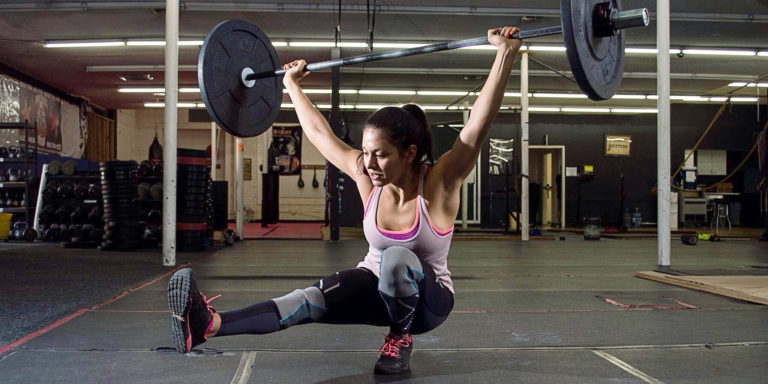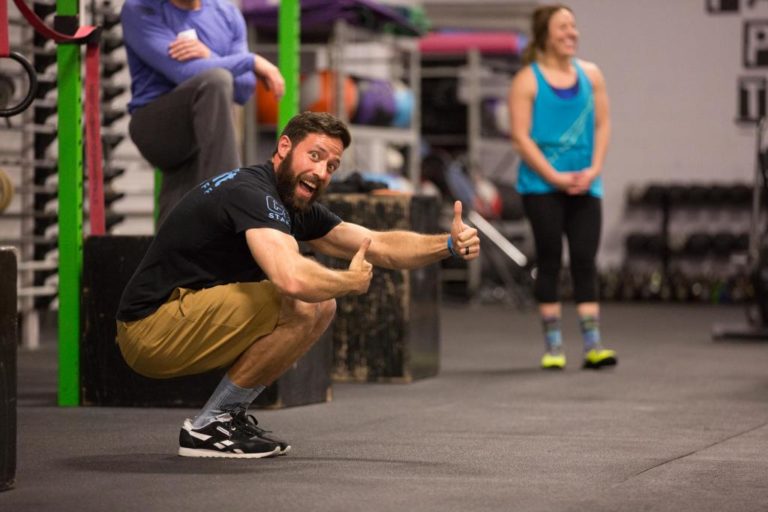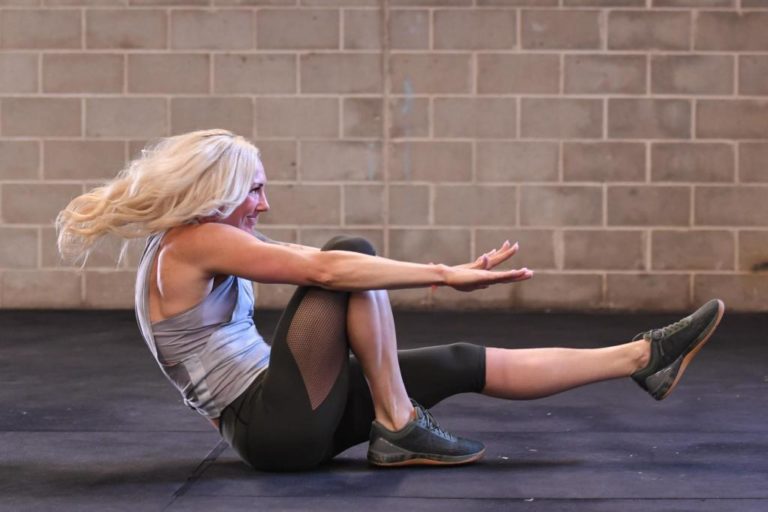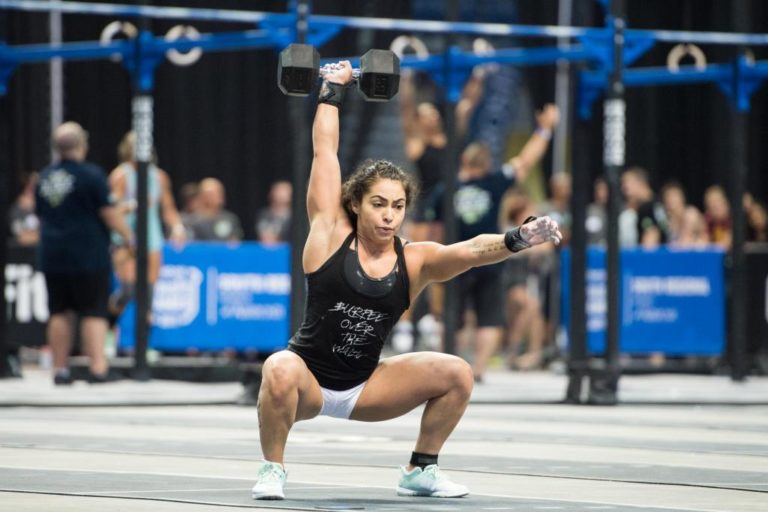Originally published August, 2018, in The CrossFit Journal.
When a CrossFit athlete thinks of a pistol, aka a one-legged squat, he or she might view the movement simply as a skill to be acquired and used in workouts. For a gymnast, acquisition of a skill does not represent an end point but rather a step in a ladder that leads to more complex and challenging skills. To a gymnast, the pistol has much more depth and transferability.

(Billy Campana / CrossFit Journal)
Gymnasts warm up with one-legged squats daily on the floor and the beam to improve balance and strength, which are both needed when landing on one leg after flips, leaps and jumps. The pistol is also useful to increase flexibility, which is needed to a greater degree if an athlete lands “short” on a tumbling pass. Overall, practicing one-legged squats ensures gymnasts have a solid base of balance, strength and flexibility. This foundation allows progress to more difficult skills and is also key to avoiding injuries.
The pistol requires a combination of balance, coordination, strength and flexibility, making it a prerequisite for loaded movements that require the same type of ankle and hip flexibility, such as the barbell overhead squat, the single-arm dumbbell overhead squat and the snatch balance. Pistol drills will ultimately improve your overhead squat by improving ankle flexibility as you lower into the squat, balance as you move through space, coordination and timing of core-to-extremity movement, and unilateral strength.
“Essential to the CrossFit concept is balanced competency in the 10 general physical skills. … Gymnastics has no peer among training modalities for developing the four neurological components of the 10 skills—coordination, agility, balance and accuracy.”
Let’s compare the mechanics of the ankle in pistols and lifts such as overhead squats, snatch balances and snatches. At the bottom of each of these movements, the weight is at the mid-foot with the heel on the ground, the ankle in dorsiflexion and the knee tracking over the toes. The position requires balance, flexibility, and strength in the muscles around the ankles, knees and hips.
Here are two drills to help athletes achieve better positioning.
The Two-Legged Pistol
This is not really a pistol but a drill to help you get pistols, and it’s a great warm-up for overhead movements.

Practice two-legged squats with your knees and feet together and one-legged squats will become easier. (Tai Randall/CrossFit Journal)
The athlete will bring the feet and legs together and stand tall. He or she can hold a 10-lb. plate out front, slightly above eye level, to help with balance. The athlete keeps the knees and feet together while moving into a squat position, going as far as possible with the knees glued together. Once the knees start to come apart, the athlete can stop and hold or try to squeeze them back together and continue lowering into a squat. The two-legged pistol aligns the hips in a more neutral position than the one-legged pistol demands. Athletes with greater ankle flexibilty will be able to go lower, and those who struggle can work to improve range of motion over time.
Practice this skill in warm-up for approximately 2 sets of 20 reps. Regular practice will lay a great foundation for the next drill.
The Candlestick Pistol
The candlestick pistol challenges balance with dynamic movement, and regular practice can help athletes adjust and recover when slightly off balance at the bottom of a snatch, snatch balance or overhead squat. The overhead squat requires great precision, while the snatch and its variations demand even more control as the athlete moves around and under a barbell while jumping the feet to the receiving/squat position. Muscle memory and spatial awareness are key components that can be mastered during the candlestick pistol.

As you roll forward, pull one foot toward your glutes and reach forward as momentum carries you into a one-legged squat. (Mike Warkentin/CrossFit Journal)
The athlete starts standing with the feet together in a hollow-body position. He or she then moves to a very low squat, keeping the knees together as much as possible (as in the two-legged pistol above). At the lowest position in the squat, the athlete starts to roll onto the back. The hands are kept in front to help balance as the feet move toward the ceiling in a candlestick (hollow body). Instead of folding at the hip, the athlete should try to keep the hip open and maintain a hollow-body position in the candlestick as he or she rolls back onto the shoulders. As the athlete’s legs swing back to the floor, he or she drives one heel toward the glutes and keeps the arms stretched out in front to provide balance as momentum carries the athlete through a one-legged squat to standing. Repeat on the other leg.
The candlestick pistol is a great warm-up before athletes perform snatches or overhead squats. The hollow position reminds the athlete to engage the core muscles, and the dynamic movement helps simulate the small adjustments in positioning that are often needed when an athlete receives an implement overhead. The use of momentum here reduces the strength requirements of the pistol, making it a great way to prepare for pistols or loaded work. Sets and reps can vary, but a great starting point is 2 sets of 12 reps (6 per leg).

As you improve flexibility, balance, strength and coordination in warm-up drills, you will be able to apply these elements to increasingly complex skills. (Thomas Campitelli/CrossFit Journal)
As a CrossFit athlete, look at how and why other sports use skill work to help athletes advance. As a former gymnast, I recognize that balance, flexibility, accuracy, strength and coordination are essential elements of both gymnastics and CrossFit. Greg Glassman, CrossFit’s Founder, has also made it clear that gymnastics and body-weight movements are integral parts of CrossFit training and the foundation for weightlifting. The more you practice the pistol—and the closer you come to mastery—the easier your barbell work will become.
About the Author:
Pamela Gagnon is a lead coach for CrossFit Gymnastics, a coach at Rising CrossFit Ballantyne, a three-time CrossFit Games masters athlete and a former collegiate gymnast.
Comments on Gymnailing It: Pistols and Overhead Squats
Thanks!
Along those lines what are some fun dynamic stretches for your t-spine?!
I really struggle with overhead squats. Barbell & Dumbbell variations. But can do pistols rather easily. Could it mean my restriction is not in my ankle dorsiflexion but in my thoracic extension?!
Could be hip/shoulder mobility and/or posterior chain strength as well
I’ll look into it.
Gymnailing It: Pistols and Overhead Squats
6